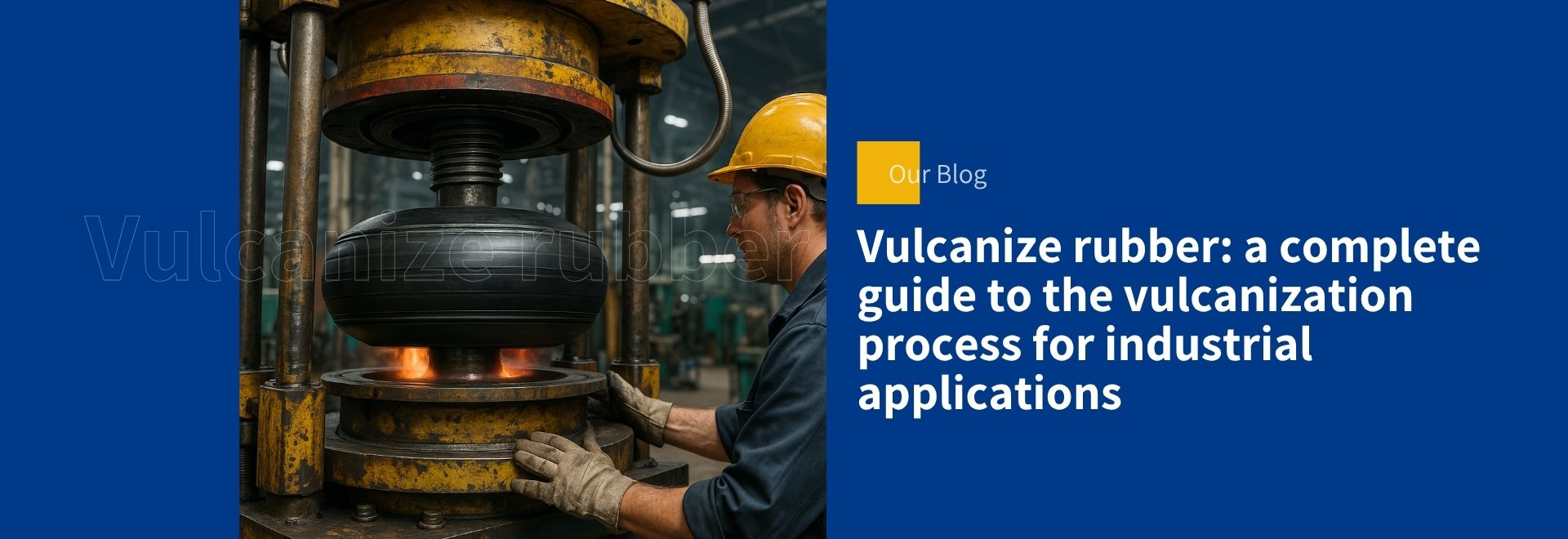
To vulcanize rubber is a crucial step in transforming a raw, deformable material into a high-performance component capable of withstanding mechanical, chemical, and thermal stress—even in extreme industrial environments.
From tire manufacturing to the production of seals, technical coatings, and automation components, rubber vulcanization is at the heart of many B2B manufacturing processes.
Why is this process so strategic for manufacturing companies? What technologies are available today to optimize time, cost, and final product quality? And most importantly, how do you choose the right vulcanization process based on the required performance?
This article explores every stage of the rubber vulcanization process, analyzing its benefits, applications, and the most advanced technological solutions to meet the demands of increasingly competitive industrial sectors.
Index
- What does it mean to vulcanize rubber, and why is it useful?
- What are the types of rubber vulcanization?
- Vulcanize rubber: main stages of the vulcanization process
- What are the industrial applications of rubber vulcanization?
What does it mean to vulcanize rubber, and why is it useful?
To vulcanize rubber means converting a naturally sticky, fragile, and weak material into a stable, elastic, and durable product. The process originates from a historic discovery by Charles Goodyear in 1839: by adding sulfur (or other vulcanizing agents) to raw rubber and applying heat, a chemical reaction is triggered, creating disulfide bridges between the polymer chains.
These cross-links permanently alter the rubber’s structure, significantly enhancing its physical and mechanical properties compared to its natural state. Vulcanization notably improves:
- Elasticity and elastic memory, essential for sealing and flexibility
- Mechanical resistance against abrasion, tension, and impact
- Thermal and dimensional stability, even under extreme temperatures or in aggressive environments
- Durability, ensuring a longer product life under harsh operating conditions
In the industrial context, these characteristics are not just a plus—they are a technical necessity.
Why is rubber vulcanization so critical in the B2B sector?
Take, for example, seals for chemical plants, membranes for hydraulic systems, or automotive components. Without an effective vulcanization process, rubber would remain too soft, unstable, and prone to irreversible deformation. The outcome? Malfunctions, downtime, and higher maintenance costs.
Relying on a controlled and optimized vulcanization process means ensuring product quality, reducing waste, and increasing application reliability. It’s a real investment in industrial efficiency and safety.
What are the types of rubber vulcanization?
In the industrial processing of elastomers, there are several technologies used to vulcanize rubber, each tailored to specific production needs, materials, and desired performance. Understanding the differences among these techniques is key to selecting the most efficient and cost-effective method for your application and production volume.
Here are the main types of rubber vulcanization used in B2B:
- Hot vulcanization: the most widely used method, ideal for high-volume and series production. It operates at temperatures between 140°C and 180°C under controlled pressure, providing a good balance between processing time and final product quality.
- Cold vulcanization: this method uses chemical accelerators to initiate crosslinking at ambient or much lower temperatures. It’s perfect for applications where heat is not feasible, or for on-site repairs, such as tire vulcanization directly in the workshop.
- Autoclave vulcanization: mainly used for thick technical components or special compounds. This method offers extremely precise control of pressure and temperature, ensuring structural uniformity and high performance, even in complex parts.
- Microwave vulcanization: one of the most promising emerging technologies. It dramatically reduces cycle times and energy consumption, making it ideal for large-scale production where operational cost optimization is essential without compromising product quality.
Vulcanize rubber: main stages of the vulcanization process
To vulcanize rubber effectively and obtain a stable, durable material suited to demanding industrial applications, a structured process with clearly defined phases is essential. Each step directly impacts the technical characteristics of the final product and overall production efficiency.
Here are the three main stages of the rubber vulcanization process:
- Mixing: the first step involves preparing the base compound by combining natural or synthetic rubber with sulfur (the vulcanizing agent), accelerators, activators, and reinforcing fillers. The quality of this step is critical: uniform dispersion of ingredients ensures a controlled, even vulcanization reaction.
- Shaping: once mixed, the compound is molded into the desired shape through extrusion, hot or cold molding, depending on the item (e.g., technical profiles, tires, gaskets, coatings). Precision in shaping affects the dimensional stability and operational performance of the final product.
- Vulcanization: this is the molecular crosslinking phase. Applying heat and pressure activates the chemical reaction between sulfur and the rubber’s polymer chains, turning it into an elastic, durable material.
- Vulcanization temperature (typically between 150°C and 180°C)
- Dwell time in the press or autoclave
Two key parameters:
Poor control can lead to serious issues: excessive heat may degrade the rubber and reduce its strength, while incomplete vulcanization results in unstable, weak, or deformable materials.
Rubber vulcanization is an enabling technology across countless production sectors, where the reliability of elastomeric materials is non-negotiable. From infrastructure to transportation, from mechanical engineering to oil & gas, vulcanized rubber components play a key role in terms of strength, durability, and safety.
Let’s look at the main industrial applications where vulcanization is essential.
Tire and wheel vulcanization
In the automotive sector, especially for industrial vehicles, safety and performance standards are extremely high. Tire vulcanization not only allows for the creation of new products that resist wear, heavy loads, and climatic variations, but also enables the regeneration of worn tires—extending their lifespan by up to 50% compared to full replacements.
This strategy is increasingly valuable in terms of circular economy and operational cost control.
Technical rubber and seals
In the industrial field, vulcanize rubber is the foundation for manufacturing seals, hoses, bellows, and membranes capable of operating in particularly harsh environments.
Typical applications include:
- Chemical and petrochemical plants
- High-pressure hydraulic and pneumatic systems
- Environments exposed to abrasives, solvents, or extreme temperatures
Thanks to vulcanization, these components achieve mechanical strength, elasticity, and chemical resistance that raw rubber could never provide.
Rubber-plastic vulcanization
In some advanced applications, vulcanization is extended to rubber-plastic blends, aiming to create composite materials with customized properties.
These hybrids combine:
- The flexibility and elasticity typical of elastomers
- The rigidity and moldability of plastics
They are used in automotive parts, anti-vibration elements, technical coatings, and solutions for acoustic or thermal insulation. Rubber-plastic vulcanization enables the development of innovative, high-performance materials for increasingly demanding market niches.
—
Rubber vulcanization is not just a technical process—it’s a strategic asset for companies operating in sectors where material reliability, durability, and safety are essential. Whether it’s vulcanizing tires, producing industrial seals, or developing high-performance composite materials, choosing the right vulcanization approach can make a significant difference in final product quality, production efficiency, and market competitiveness.
In a B2B context increasingly focused on sustainability and cost optimization, having advanced technologies to vulcanize rubber and relying on a partner with solid experience in the field can deliver real, measurable advantages.


